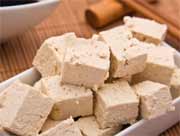
TUESDAY, March 26 (HealthDay News) — Eating tofu and other soy foods may help women who develop lung cancer increase their odds of living longer.
A study of women from Shanghai, China, published in the March 25 issue of the Journal of Clinical Oncology, links high soy consumption before a lung cancer diagnosis with longer survival.
“This is the first study to suggest an association between soy food consumption and lung cancer survival,” said study author Dr. Gong Yang, a research associate professor of medicine in the division of epidemiology at Vanderbilt University Medical Center, in Nashville.
Eating soy products in small amounts in the years preceding a lung cancer diagnosis didn’t seem to pose a benefit, though.
Lung cancer is the leading cause of death among women in the world. It forms in the tissues of the lungs, usually in the cells that line the air passageways. The five-year survival rate is poor compared to breast cancer; it is estimated that by 2012, lung cancer will cause twice as many deaths as breast cancer, Yang said.
Cigarette smoking is the top cause of the disease in the United States, according to the U.S. Centers for Disease Control and Prevention, but in the study, most of the women from China were nonsmokers.
One expert noted another difference between the two populations of women that does not bode well for Chinese women.
“Far more never-smoking women in Asia get lung cancer than in the United States,” said Dr. Jyoti Patel, an associate professor of medicine at the Robert H. Lurie Comprehensive Cancer Center at the Northwestern University Feinberg School of Medicine, in Chicago. “We’re not sure why this is, but they may have a predilection for developing mutations … that cause lung cancer to grow.”
The study participants were part of a larger observational study called the Shanghai Women’s Health Study, which tracked the incidence of cancer in about 75,000 women. Diet information was collected, including how much soy food — such as soy milk, tofu, fresh and dry soybeans, and soy sprouts — women ate.
The authors reported that about 450 women were diagnosed with lung cancer during the study. They were divided into three groups according to the amount of soy food they had eaten before their lung cancer diagnosis. The highest intake levels of tofu were equal to about 4 ounces a day, while the lowest soy consumers ate less than 2 ounces daily.
During the study, more than 300 of the lung cancer patients died, Yang said. Sixty percent of the women in the highest soy-eating group and 50 percent in the low soy consumer group were alive twelve months after diagnosis. A patient’s risk of death decreased with increasing soy intake, but leveled off at 4 ounces of daily tofu consumption.
“Patients with the highest soy food intake had better overall survival compared with those with the lowest intake,” said Yang, who described the association as “linear.”
What is in soybeans that might have cancer-slowing properties? It contains isoflavones that can act like selective estrogen modulators (SERMS), similar to the breast-cancer-fighting drug tamoxifen, Patel said.
“These SERMS may have a protective effect in lung cancer because we know that estrogen receptors are present in lung cancer and are important in lung development,” Patel said.
Elisabetta Politi, nutrition director at the Duke Diet and Fitness Center in Durham, N.C., said the study is promising, but it raises a lot of questions too: Does the age at which soy is consumed play a role in how well it fights cancer later? Are certain soy foods better than others at fighting cancer? Would the results translate to a non-Chinese population?
“Maybe soy is important to eat before puberty,” Politi said, noting that some studies suggest breast cancer risk is linked to earlier puberty. She said most American women don’t eat soy before puberty, though. “It’s not a typical staple in the American diet.”
The new research also only collected information on soy intake before a lung cancer diagnosis, Politi said. People who already have lung cancer may wonder if adding tofu or soymilk to their daily diets could help.
Politi said she thinks it’s too early to recommend boosting soy intake specifically for lung cancer survival reasons but she encourages people to try adding it to their diets.
“It’s a good source of vegetable protein. I call it the miracle bean because it has about 30 percent of calories from protein, 30 percent from fat and 30 percent from carbohydrates. It’s also high in fiber and often fortified with calcium. It’s very nutritious,” Politi said. “I do think soy in moderation is part of a healthy plant-based diet and I would recommend it, but not in high consumption for breakfast, lunch, snack and dinner.”
The study authors also said it is premature to make any dietary recommendation on the basis of this single study, which did not prove a cause-and-effect relationship between soy and increased survival.
“Further investigation is warranted to confirm or refute this finding,” Yang said. “We’d like to test this in other populations, too, like smokers or postmenopausal estrogen users, to answer the question of whether eating soy after diagnosis has a similar effect.”
The research was supported by the U.S. National Cancer Institute and conducted by investigators at Vanderbilt University in collaboration with the Shanghai Cancer Institute and U.S. National Cancer Institute.
More information
For more on soy and cancer, go to the American Cancer Society.

